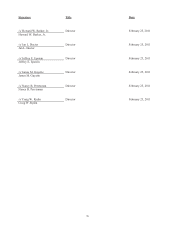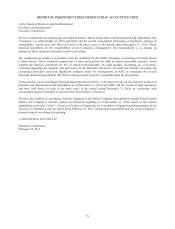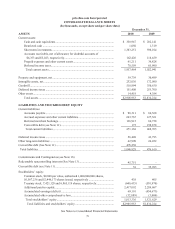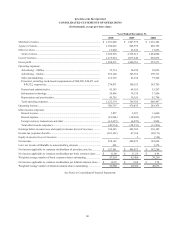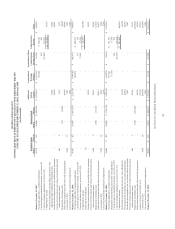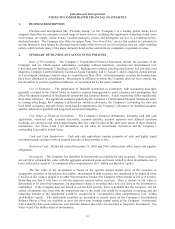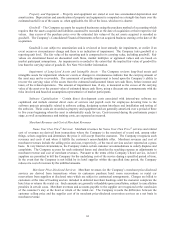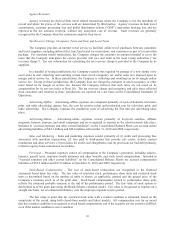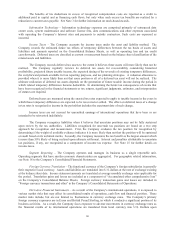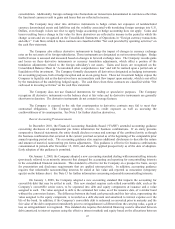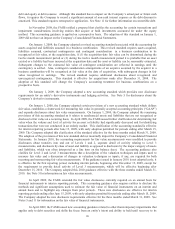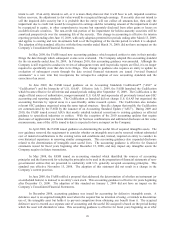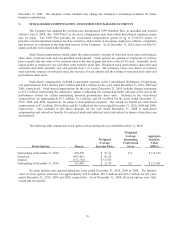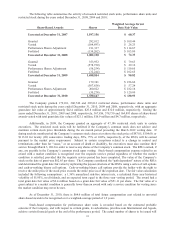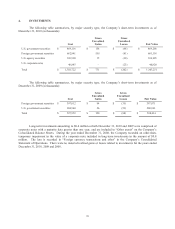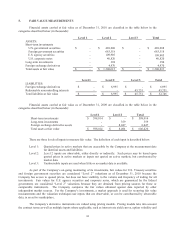Priceline 2010 Annual Report Download - page 158
Download and view the complete annual report
Please find page 158 of the 2010 Priceline annual report below. You can navigate through the pages in the report by either clicking on the pages listed below, or by using the keyword search tool below to find specific information within the annual report.84
Property and Equipment – Property and equipment are stated at cost less accumulated depreciation and
amortization. Depreciation and amortization of property and equipment is computed on a straight-line basis over the
estimated useful lives of the assets or, when applicable, the life of the lease, whichever is shorter.
Goodwill – The Company accounts for acquired businesses using the purchase method of accounting which
requires that the assets acquired and liabilities assumed be recorded at the date of acquisition at their respective fair
values. Any excess of the purchase price over the estimated fair values of the net assets acquired is recorded as
goodwill. The Company’s Consolidated Financial Statements reflect an acquired business starting at the date of the
acquisition.
Goodwill is not subject to amortization and is reviewed at least annually for impairment, or earlier if an
event occurs or circumstances change and there is an indication of impairment. The Company tests goodwill at a
reporting unit level. The fair value of the reporting unit is compared to its carrying value, including goodwill. Fair
values are determined based on discounted cash flows, market multiples or appraised values and are based on
market participant assumptions. An impairment is recorded to the extent that the implied fair value of goodwill is
less than the carrying value of goodwill. See Note 9 for further information.
Impairment of Long-Lived Assets and Intangible Assets – The Company reviews long-lived assets and
intangible assets for impairment whenever events or changes in circumstances indicate that the carrying amount of
the asset may not be recoverable. The assessment of possible impairment is based upon the Company’s ability to
recover the carrying value of the assets from the estimated undiscounted future net cash flows, before interest and
taxes, of the related operations. The amount of impairment loss, if any, is measured as the excess of the carrying
value of the asset over the present value of estimated future cash flows, using a discount rate commensurate with the
risks involved and based on assumptions representative of market participants.
Software Capitalization – Certain direct development costs associated with internal-use software are
capitalized and include external direct costs of services and payroll costs for employees devoting time to the
software projects principally related to software coding, designing system interfaces and installation and testing of
the software. These costs are recorded as property and equipment and are generally amortized over a period of three
to five years beginning when the asset is substantially ready for use. Costs incurred during the preliminary project
stage, as well as maintenance and training costs, are expensed as incurred.
Merchant Revenues and Cost of Merchant Revenues
Name Your Own Price® Services: Merchant revenues for Name Your Own Price® services and related
cost of revenues are derived from transactions where the Company is the merchant of record and, among other
things, selects suppliers and determines the price it will accept from the customer. The Company recognizes such
revenues and costs if and when it fulfills the customer’s non-refundable offer. Merchant revenues and cost of
merchant revenues include the selling price and cost, respectively, of the travel services and are reported on a gross
basis. In very limited circumstances, the Company makes certain customer accommodations to satisfy disputes and
complaints. The Company accrues for such estimated losses and classifies the resulting expense as adjustments to
merchant revenue and cost of merchant revenues. Pursuant to the terms of the Company’s hotel service, its hotel
suppliers are permitted to bill the Company for the underlying cost of the service during a specified period of time.
In the event that the Company is not billed by its hotel supplier within the specified time period, the Company
reduces its cost of revenues by the unbilled amounts.
Merchant Price-Disclosed Services: Merchant revenues for the Company’s merchant price-disclosed
services are derived from transactions where its customers purchase hotel room reservations or rental car
reservations from suppliers at disclosed rates which are subject to contractual arrangements. Charges are billed to
customers at the time of booking and are included in deferred merchant bookings until the customer completes the
hotel stay or returns the rental car. Such amounts are generally refundable upon cancellation, subject to cancellation
penalties in certain cases. Merchant revenues and accounts payable to the supplier are recognized at the conclusion
of the customer’s stay at the hotel or return of the rental car. The Company records the difference between the
customer selling price and the supplier cost of its merchant price-disclosed reservation services on a net basis in
merchant revenue.




